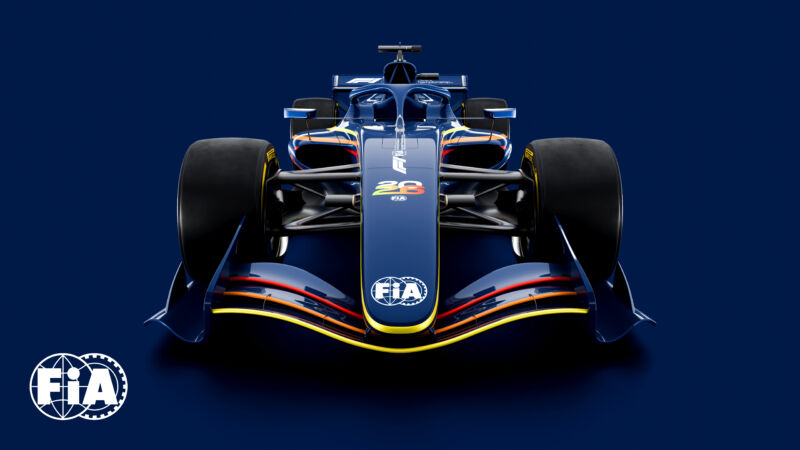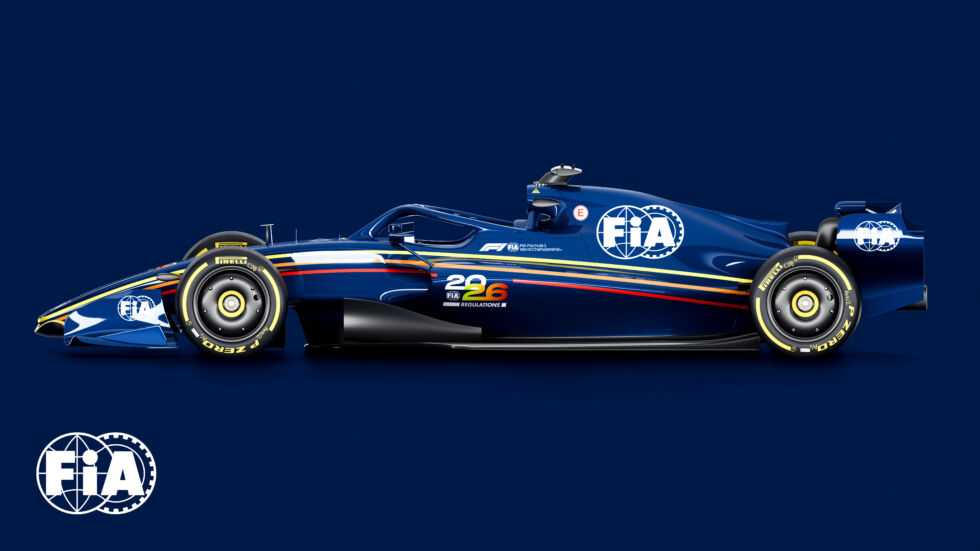Moveable wings cut drag on the straights, hybrid boost will help overtakes.

Earlier today, the Fédération Internationale de l’Automobile laid out the direction for Formula 1’s next set of technical regulations, which will go into effect in 2026. It will be the second big shakeup of F1’s technical regs since 2022 and involves sweeping changes to the hybrid powertrain and a fundamental rethink of how some of the aerodynamics work.
“With this set of regulations, the FIA has sought to develop a new generation of cars that are fully in touch with the DNA of Formula 1—cars that are light, supremely fast and agile but which also remains at the cutting edge of technology, and to achieve this we worked towards what we called a ‘nimble car’ concept. At the center of that vision is a redesigned power unit that features a more even split between the power derived from the internal combustion element and electrical power,” said Nikolas Tombazis, the FIA’s single-seater technical director.
Didn’t we just get new rules?
It feels like F1 only just got through its last big rule change with the (re)introduction of ground-effect cars at the start of 2022. Since the early 1980s, F1 cars have generated aerodynamic grip, or downforce, via front and rear wings. But drivers found it increasingly difficult to follow each other closely through corners as the dirty air from the car in front starved the following car’s front wing of air, robbing it of cornering grip in the process.
ADVERTISING
The 2022 rules changed this, requiring cars to use a sculpted floor that generates downforce via the venturi effect. This reduced the importance of the front wing, and indeed, the cars were able to race closely in 2022. In two years’ time, F1 cars will use less complicated floors with smaller venturis that generate a smaller ground effect, which the FIA says should mean no more having to run “ultra-stiff and low setups” to avoid the problem of porpoising.
Overall downforce is being reduced by 30 percent, but there’s an even greater reduction in drag—55 percent is the target, which is being done in part to accommodate the new hybrid powertrain.
More hybrid power
The V6 internal combustion engine is becoming less powerful, dropping to an output of 536 hp (400 kW), but the electric motor that also drives the rear wheels will now generate 470 hp (350 kW). That leaves the combined power output roughly where it is today, but only when the battery has enough charge. However, cars will be allowed to harvest twice as much energy (8.5 MJ) per lap under braking as now.
And as Ars has covered in the past, the engines will run on drop-in sustainable fuels. The new engine regulations have succeeded in tempting Honda back into the sport, as well as bringing in Ford and Audi, and possibly Cadillac in time.
Since the cars will be less powerful when they’re just running on internal combustion, more than halving the amount of drag they experience means they shouldn’t be too slow along the straights.
When F1 first introduced its original hybrid, called KERS (for kinetic energy recovery system), the electric motor boost was something the driver could use on demand. But that changed when the current powertrain rules came into effect in 2014, and it became up to the car to decide when to deploy energy from the battery to supplement the V6 motor.
In 2026, that changes again. The hybrid system is programmed to use less of the electric motor’s power as speeds pass 180 mph (270 km/h), down to zero at 220 mph (355 km/h), relying just on the V6 by then. But if a car is following within a second, the chasing driver can override that cutoff, allowing the full 470 hp from the electric motor at speeds of up to 209 mph (337 km/h), with up to half a MJ of extra energy.
ARS VIDEO
What Happens to the Developers When AI Can Code? | Ars Frontiers
Active aero
There’s another philosophical change coming to the aero regulations for 2026, with a greater embrace of active aerodynamics. When racers first started fitting wings to cars in the 1960s, they sometimes included actuators that could change the wing profile on command to reduce drag down the straight or increase downforce in the corners. But those active wings were prone to failure, and since crashing in the 1960s often meant dying, it’s easy to see why the sport banned moveable aerodynamic devices.

That rule has been used to outlaw many innovative ideas over the years, but F1 made an exception when it added a rule requiring a “drag reduction system” on each car. This allows the driver to lower an element of the rear wing to cut drag (and therefore increase speed). The system can be activated at certain zones at each race track, as long as the car is within a second of a car in front since it’s supposed to be an overtaking aid.
For 2026, DRS is gone, but both the front and rear wings will have active elements, which will move in concert. But instead of moving to a low-drag configuration to overtake, that will be the default for driving along the straights—called X-Mode. Only when the cars begin to brake and corner do the wing elements pop up into their higher-downforce configuration, which the FIA calls Z-Mode.
Other aero tweaks aim to reduce or control the wake generated by wheels as they rotate.
Smaller, lighter, safer
The front wing will be 100 mm narrower than the current front wing, part of a reduction in size and mass that should see the 2026 car lose 30 kg compared to today’s machinery. The overall width is reduced to 1,900 mm. The wheelbase is 200 mm shorter at 3,400 mm.
The 18-inch wheels, which replaced the 13-inch items used until 2022, are staying. But the tires are getting a little narrower—25 mm at the front and 35 mm at the rear—which will reduce drag and, importantly, unsprung weight, hopefully adding a little spryness back to the formula.
The cars should become even safer, too. There are new front-impact regulations that require the car to survive a two-stage crash, reflecting the reality that in some multi-car crashes, not all the impacts occur simultaneously. The sides of the car’s carbon fiber chassis tub will need to better protect the driver and fuel cells from intrusions, although the FIA says this won’t add more weight to the cars. Other safety tweaks include a strengthened roll hoop and brighter lights on the rear wing endplates.
“These regulations mark a significant moment in the future of our sport as we look forward to a new generation of car and power unit that aims to give our fans closer and exciting racing,” said F1 CEO Stefano Domenicali. “We enter this new regulatory cycle with the sport in the strongest position it has ever been, and I am confident that the work done by the FIA to create these regulations will further strengthen the position of the sport around the world.”




